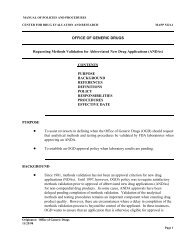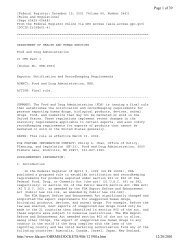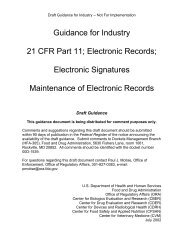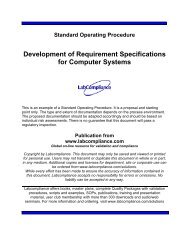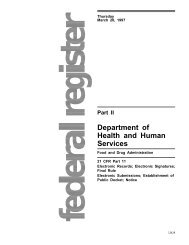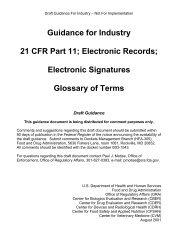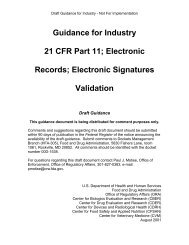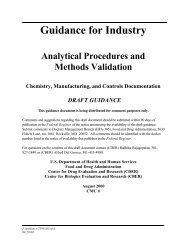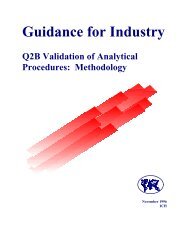Guidance for Off-The-Shelf Software Use in Medical Devices
Guidance for Off-The-Shelf Software Use in Medical Devices
Guidance for Off-The-Shelf Software Use in Medical Devices
Create successful ePaper yourself
Turn your PDF publications into a flip-book with our unique Google optimized e-Paper software.
<strong>The</strong> review team must decide whether the overall programmer system as implemented satisfiesthe necessary system safety and effectiveness (see section 2.5).3.2 510(k) Issues with OTS <strong>Software</strong><strong>The</strong> conditions under which a new or changed medical device <strong>in</strong>clud<strong>in</strong>g OTS <strong>Software</strong> willrequire a new 510(k) are the same as <strong>for</strong> a device not <strong>in</strong>volv<strong>in</strong>g OTS <strong>Software</strong>. <strong>The</strong>se conditionsare given <strong>in</strong> CDRH’s guidance Decid<strong>in</strong>g When to Submit a 510(k) <strong>for</strong> a Change to an Exist<strong>in</strong>gDevice [3]. <strong>The</strong> section (B) on Technology Eng<strong>in</strong>eer<strong>in</strong>g and Per<strong>for</strong>mance Changes <strong>in</strong> the 510(k)guidance is most applicable to OTS <strong>Software</strong>.Section B of the guidance <strong>in</strong>cludes the follow<strong>in</strong>g questions:• B1 Is it (the modification) a control mechanism change?• B2 Is it an operat<strong>in</strong>g pr<strong>in</strong>ciple change?• B5 Is it a change <strong>in</strong> per<strong>for</strong>mance specifications?• B8 Is it a change <strong>in</strong> software or firmware? <strong>The</strong> types of changes identified <strong>in</strong> questions B4through B8 have frequently been called design changes or eng<strong>in</strong>eer<strong>in</strong>g changes. <strong>The</strong>yencompass everyth<strong>in</strong>g from the rout<strong>in</strong>e specification changes necessary to ma<strong>in</strong>ta<strong>in</strong> or improvemedical device per<strong>for</strong>mance as a result of feedback from users, field or plant personnel, etc.,up to and <strong>in</strong>clud<strong>in</strong>g significant product redesign.• B8.1 Does the change affect the <strong>in</strong>dications <strong>for</strong> use? As with an explicit label<strong>in</strong>g change, if thechange affects the <strong>in</strong>dications <strong>for</strong> use, i.e., if it creates an implied new <strong>in</strong>dication <strong>for</strong> use, a new510(k) should be submitted.• B8.2 Are cl<strong>in</strong>ical data necessary to evaluate safety and effectiveness <strong>for</strong> purposes ofdeterm<strong>in</strong><strong>in</strong>g substantial equivalence? Whenever a manufacturer recognizes that cl<strong>in</strong>ical dataare needed because bench test<strong>in</strong>g or simulations are not sufficient to assess safety andeffectiveness and, thus, to establish the substantial equivalence of a new design, a 510(k)should be submitted.• B8.3 Do results of design validation raise new issues of safety and effectiveness? All changesto medical device design will require some level of design validation or evaluation to assurethat the device cont<strong>in</strong>ues to per<strong>for</strong>m as <strong>in</strong>tended. <strong>The</strong> successful application of rout<strong>in</strong>e designvalidation activities will logically result <strong>in</strong> manufacturers document<strong>in</strong>g their ef<strong>for</strong>ts andproceed<strong>in</strong>g with the design change, i.e., assur<strong>in</strong>g that no issues of safety or effectiveness areraised.A yes answer to any of these questions <strong>in</strong> section B will generally require a new 510(k).OTS <strong>Software</strong> <strong>Guidance</strong>, F<strong>in</strong>al page 15




